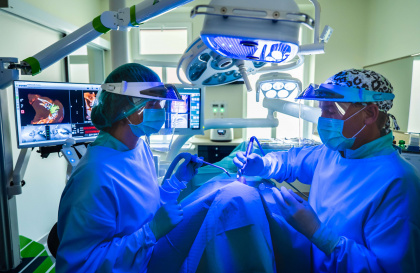Reception: ![]() +36/30 show
+36/30 show
6721 Szeged, Osztrovszky utca 12.
Open every week-day since 1996
Open on week-days from 8 AM to 9 PM
24 578 satisfied customers
Serving you since 1996
The X-Guide dynamic navigation implant system is the most accurate method available up to the present day to install a dental implant. Like a GPS, it navigates the dentist step by step through the implant procedure.
The X-Guide dynamic navigation system is already well known, and world widely used with success. Therefore, we are especially glad and proud to use it, uniquely in the Dél-Alföld Region (Southern Great Plain), in our Dentha Ultramodern Dental and Implantology Clinic, at Szeged. Our dentists, based upon a previous dental CT, plan the exact location of the implant within the bone-structure, considering the anatomic relations, the neighbouring teeth, the available bone quantity and quality, and the expected axe-position. The optical navigation system helps inserting the implant to a 10th of a millimetre accuracy there, where it was expected to be, in perfect accordance with the correct angles.
The X-Guide navigation system has been developed for experienced odontologists, to make them capable of executing the implant surgery on a highest-ever accuracy and safety level. During the intervention, the device shows in real-time the dental drill position (angles, depth, and axe-position) and monitors the itinerary by which the implant reaches its expected and required destination. Essentially, it shows the implant position previously planned by the dentist with the help of a software: it shows the right steps of the insertion- how exactly and in which position and depth, by what angles the implant should be inserted in the mouth to reach the required result.
This is why it’s called a GPS-like procedure: we plan where we want to go and the GPS guides us right to the destination. Since the earlier taken digital imprint can be scanned together with the plan, thus, by the time of making the plan, we can already count on the location of the future crown as well. Moreover, the dental technician can prepare, already before the implant procedure, the temporary crown by CAD/CAM technology, which can be inserted right after installing the implant.
vissza a kérdésekhez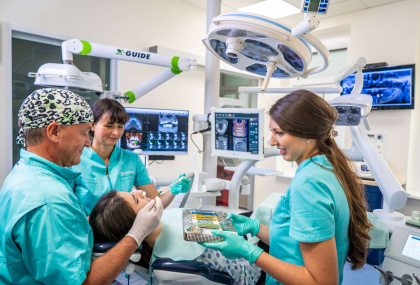
In the X-Guide system, we plan the implants based on the tooth CT and when inserting the implant, the software shows the dentist the itinerary to follow during the procedure. Doing so, it provides a real time feed back about the angles, the itinerary, the axe position, and the depth, and minimises the chance of any failure.
vissza a kérdésekhez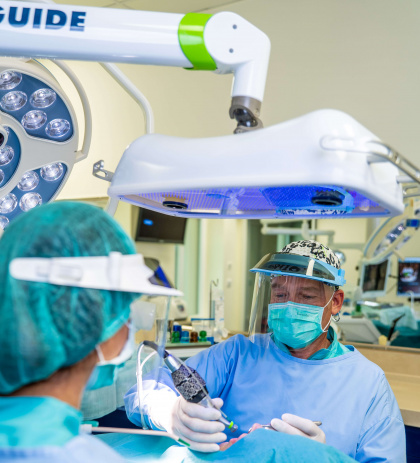
In the past, the implantologist had executed the insertions manually, controlling the process by simple eye inspection. Later occurred the dental surgical guides, which helped the odontologist to insert the implant. However, these dispose of a certain number of disadvantageous qualities, for example, it is not possible to ensure a sufficient cooling effect through these guides. Another difficulty is the loss of eye control and consequently the loss of any chance for modifications during the intervention. Thus, due to anatomic limits, these guides are not always adaptable.
Nowadays, the most up-to-date and secure procedure is the dynamic navigation implant surgery, where we can detect on the screen of our computer the precise axe position of the implant and our manual movements, even meanwhile the dentist’s hands are not locked (like when using the dental surgical guide) This means, that if suddenly an unexpected factor occurs, it is possible to modify the plan and to continue accordingly. Moreover, since we don’t need to put any kind of guide on the implant surgery zone, the indispensable water cooling is also resolved.
The future is undoubtedly the robot surgery, which partly or completely replaces the implantologist’s work. The success of the dynamic navigation implant surgery method is based on the accurate planification by CBCT, with the help of an adequate software.
vissza a kérdésekhez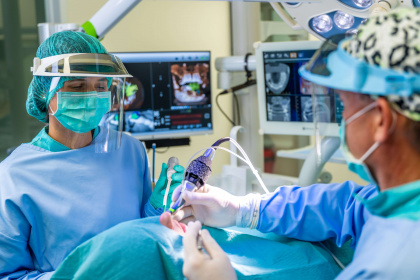
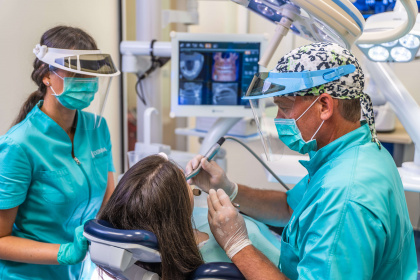
Advantages:
Disadvantages:
